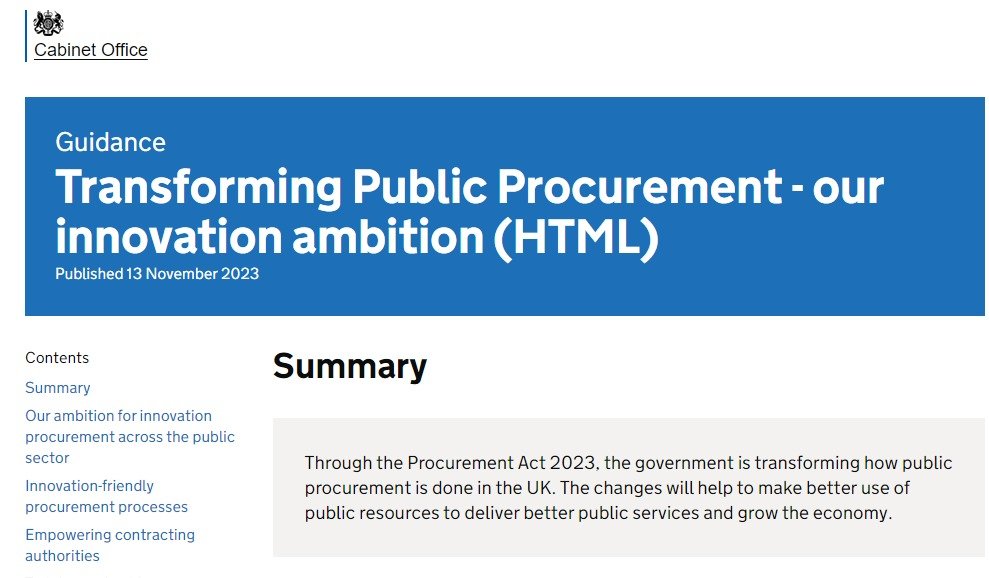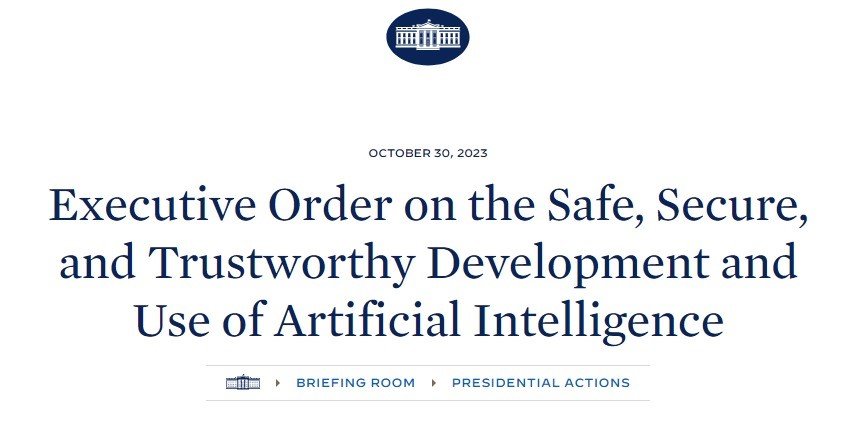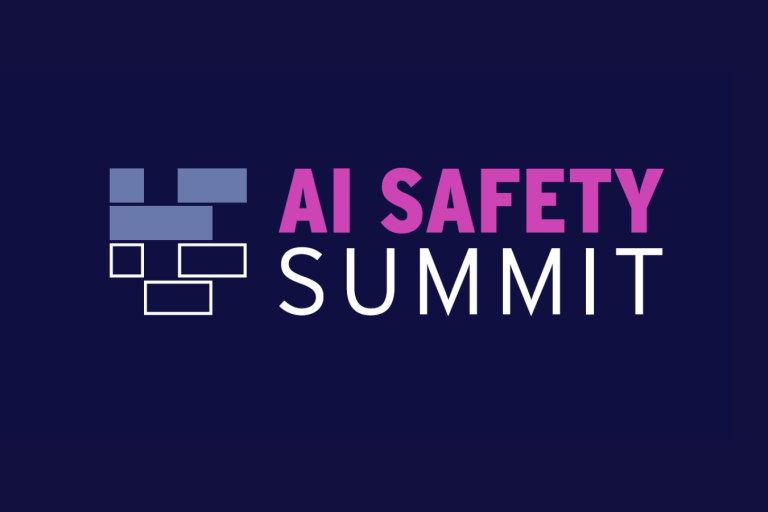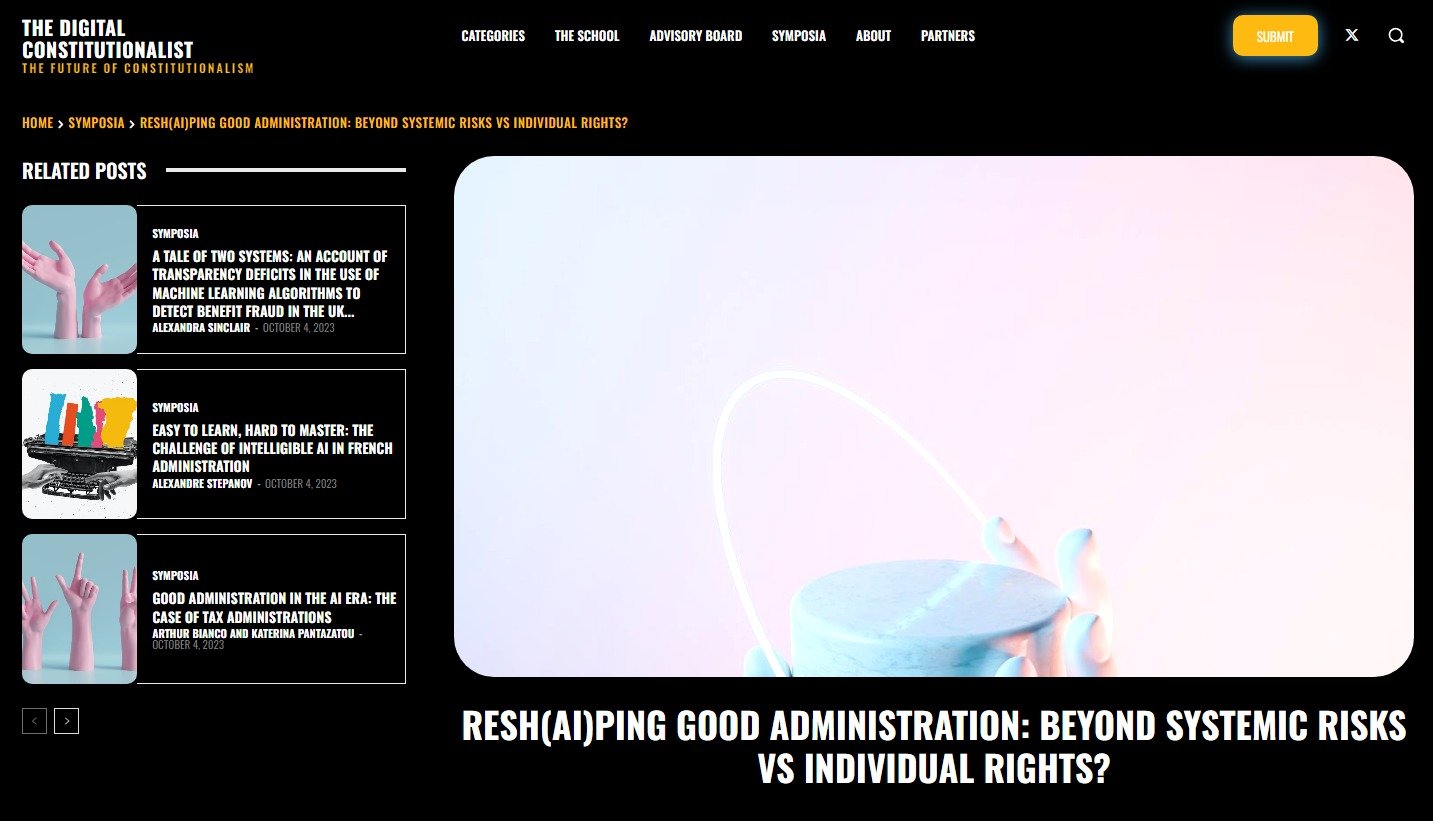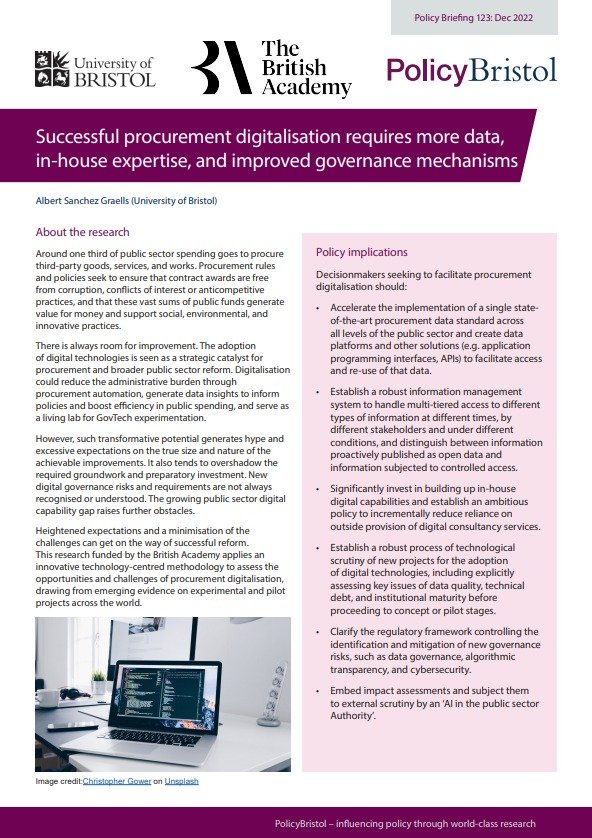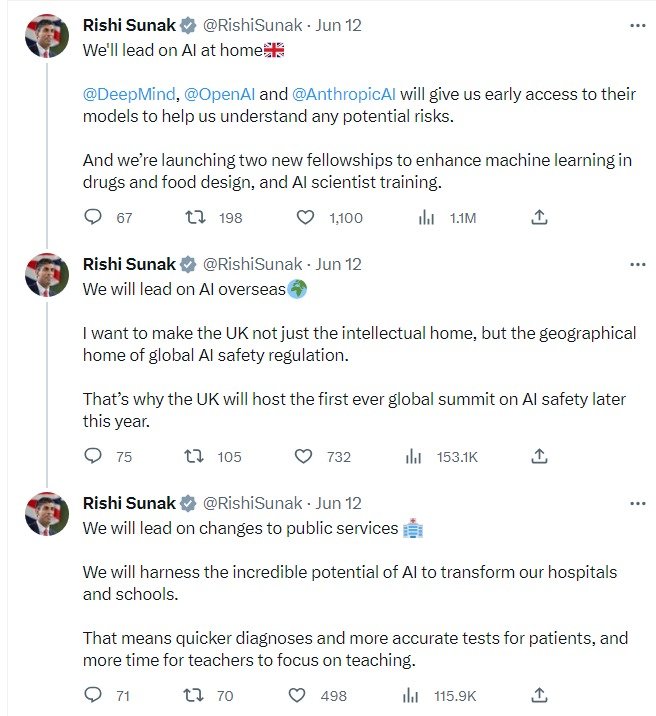On 30 October 2023, President Biden adopted the Executive Order on the Safe, Secure, and Trustworthy Development and Use of Artificial Intelligence (the ‘AI Executive Order’, see also its Factsheet). The use of AI by the US Federal Government is an important focus of the AI Executive Order. It will be subject to a new governance regime detailed in the Draft Policy on the use of AI in the Federal Government (the ‘Draft AI in Government Policy’, see also its Factsheet), which is open for comment until 5 December 2023. Here, I reflect on these documents from the perspective of AI procurement as a major plank of this governance reform.
Procurement in the AI Executive Order
Section 2 of the AI Executive Order formulates eight guiding principles and priorities in advancing and governing the development and use of AI. Section 2(g) refers to AI risk management, and states that
It is important to manage the risks from the Federal Government’s own use of AI and increase its internal capacity to regulate, govern, and support responsible use of AI to deliver better results for Americans. These efforts start with people, our Nation’s greatest asset. My Administration will take steps to attract, retain, and develop public service-oriented AI professionals, including from underserved communities, across disciplines — including technology, policy, managerial, procurement, regulatory, ethical, governance, and legal fields — and ease AI professionals’ path into the Federal Government to help harness and govern AI. The Federal Government will work to ensure that all members of its workforce receive adequate training to understand the benefits, risks, and limitations of AI for their job functions, and to modernize Federal Government information technology infrastructure, remove bureaucratic obstacles, and ensure that safe and rights-respecting AI is adopted, deployed, and used.
Section 10 then establishes specific measures to advance Federal Government use of AI. Section 10.1(b) details a set of governance reforms to be implemented in view of the Director of the Office of Management and Budget (OMB)’s guidance to strengthen the effective and appropriate use of AI, advance AI innovation, and manage risks from AI in the Federal Government. Section 10.1(b) includes the following (emphases added):
The Director of OMB’s guidance shall specify, to the extent appropriate and consistent with applicable law:
(i) the requirement to designate at each agency within 60 days of the issuance of the guidance a Chief Artificial Intelligence Officer who shall hold primary responsibility in their agency, in coordination with other responsible officials, for coordinating their agency’s use of AI, promoting AI innovation in their agency, managing risks from their agency’s use of AI …;
(ii) the Chief Artificial Intelligence Officers’ roles, responsibilities, seniority, position, and reporting structures;
(iii) for [covered] agencies […], the creation of internal Artificial Intelligence Governance Boards, or other appropriate mechanisms, at each agency within 60 days of the issuance of the guidance to coordinate and govern AI issues through relevant senior leaders from across the agency;
(iv) required minimum risk-management practices for Government uses of AI that impact people’s rights or safety, including, where appropriate, the following practices derived from OSTP’s Blueprint for an AI Bill of Rights and the NIST AI Risk Management Framework: conducting public consultation; assessing data quality; assessing and mitigating disparate impacts and algorithmic discrimination; providing notice of the use of AI; continuously monitoring and evaluating deployed AI; and granting human consideration and remedies for adverse decisions made using AI;
(v) specific Federal Government uses of AI that are presumed by default to impact rights or safety;
(vi) recommendations to agencies to reduce barriers to the responsible use of AI, including barriers related to information technology infrastructure, data, workforce, budgetary restrictions, and cybersecurity processes;
(vii) requirements that [covered] agencies […] develop AI strategies and pursue high-impact AI use cases;
(viii) in consultation with the Secretary of Commerce, the Secretary of Homeland Security, and the heads of other appropriate agencies as determined by the Director of OMB, recommendations to agencies regarding:
(A) external testing for AI, including AI red-teaming for generative AI, to be developed in coordination with the Cybersecurity and Infrastructure Security Agency;
(B) testing and safeguards against discriminatory, misleading, inflammatory, unsafe, or deceptive outputs, as well as against producing child sexual abuse material and against producing non-consensual intimate imagery of real individuals (including intimate digital depictions of the body or body parts of an identifiable individual), for generative AI;
(C) reasonable steps to watermark or otherwise label output from generative AI;
(D) application of the mandatory minimum risk-management practices defined under subsection 10.1(b)(iv) of this section to procured AI;
(E) independent evaluation of vendors’ claims concerning both the effectiveness and risk mitigation of their AI offerings;
(F) documentation and oversight of procured AI;
(G) maximizing the value to agencies when relying on contractors to use and enrich Federal Government data for the purposes of AI development and operation;
(H) provision of incentives for the continuous improvement of procured AI; and
(I) training on AI in accordance with the principles set out in this order and in other references related to AI listed herein; and
(ix) requirements for public reporting on compliance with this guidance.
Section 10.1(b) of the AI Executive Order establishes two sets or types of requirements.
First, there are internal governance requirements and these revolve around the appointment of Chief Artificial Intelligence Officers (CAIOs), AI Governance Boards, their roles, and support structures. This set of requirements seeks to strengthen the ability of Federal Agencies to understand AI and to provide effective safeguards in its governmental use. The crucial set of substantive protections from this internal perspective derives from the required minimum risk-management practices for Government uses of AI, which is directly placed under the responsibility of the relevant CAIO.
Second, there are external (or relational) governance requirements that revolve around the agency’s ability to control and challenge tech providers. This involves the transfer (back to back) of minimum risk-management practices to AI contractors, but also includes commercial considerations. The tone of the Executive Order indicates that this set of requirements is meant to neutralise risks of commercial capture and commercial determination by imposing oversight and external verification. From an AI procurement governance perspective, the requirements in Section 10.1(b)(viii) are particularly relevant. As some of those requirements will need further development with a view to their operationalisation, Section 10.1(d)(ii) of the AI Executive Order requires the Director of OMB to develop an initial means to ensure that agency contracts for the acquisition of AI systems and services align with its Section 10.1(b) guidance.
Procurement in the Draft AI in Government Policy
The guidance required by Section 10.1(b) of the AI Executive Order has been formulated in the Draft AI in Government Policy, which offers more detail on the relevant governance mechanisms and the requirements for AI procurement. Section 5 on managing risks from the use of AI is particularly relevant from an AI procurement perspective. While Section 5(d) refers explicitly to managing risks in AI procurement, given that the primary substantive obligations will arise from the need to comply with the required minimum risk-management practices for Government uses of AI, this specific guidance needs to be read in the broader context of AI risk-management within Section 5 of the Draft AI in Government Policy.
Scope
The Draft AI in Government Policy relies on a tiered approach to AI risk by imposing specific obligations in relation to safety-impacting and rights-impacting AI only. This is an important element of the policy because these two categories are defined (in Section 6) and in principle will cover pre-established lists of AI use, based on a set of presumptions (Section 5(b)(i) and (ii)). However, CAIOs will be able to waive the application of minimum requirements for specific AI uses where, ‘based upon a system-specific risk assessment, [it is shown] that fulfilling the requirement would increase risks to safety or rights overall or would create an unacceptable impediment to critical agency operations‘ (Section 5(c)(iii)). Therefore, these are not closed lists and the specific scope of coverage of the policy will vary with such determinations. There are also some exclusions from minimum requirements where the AI is used for narrow purposes (Section 5(c)(i))—notably the ‘Evaluation of a potential vendor, commercial capability, or freely available AI capability that is not otherwise used in agency operations, solely for the purpose of making a procurement or acquisition decision’; AI evaluation in the context of regulatory enforcement, law enforcement or national security action; or research and development.
This scope of the policy may be under-inclusive, or generate risks of under-inclusiveness at the boundary, in two respects. First, the way AI is defined for the purposes of the Draft AI in Government Policy, excludes ‘robotic process automation or other systems whose behavior is defined only by human-defined rules or that learn solely by repeating an observed practice exactly as it was conducted’ (Section 6). This could be under-inclusive to the extent that the minimum risk-management practices for Government uses of AI create requirements that are not otherwise applicable to Government use of (non-AI) algorithms. There is a commonality of risks (eg discrimination, data governance risks) that would be better managed if there was a joined up approach. Moreover, developing minimum practices in relation to those means of automation would serve to develop institutional capability that could then support the adoption of AI as defined in the policy. Second, the variability in coverage stemming from consideration of ‘unacceptable impediments to critical agency operations‘ opens the door to potentially problematic waivers. While these are subject to disclosure and notification to OMB, it is not entirely clear on what grounds OMB could challenge those waivers. This is thus an area where the guidance may require further development.
extensions and waivers
In relation to covered safety-impacting or rights-impacting AI (as above), Section 5(a)(i) establishes the important principle that US Federal Government agencies have until 1 August 2024 to implement the minimum practices in Section 5(c), ‘or else stop using any AI that is not compliant with the minimum practices’. This type of sunset clause concerning the currently implicit authorisation for the use of AI is a potentially powerful mechanism. However, the Draft also establishes that such obligation to discontinue non-compliant AI use must be ‘consistent with the details and caveats in that section [5(c)]’, which includes the possibility, until 1 August 2024, for agencies to
request from OMB an extension of limited and defined duration for a particular use of AI that cannot feasibly meet the minimum requirements in this section by that date. The request must be accompanied by a detailed justification for why the agency cannot achieve compliance for the use case in question and what practices the agency has in place to mitigate the risks from noncompliance, as well as a plan for how the agency will come to implement the full set of required minimum practices from this section.
Again, the guidance does not detail on what grounds OMB would grant those extensions or how long they would be for. There is a clear interaction between the extension and waiver mechanism. For example, an agency that saw its request for an extension declined could try to waive that particular AI use—or agencies could simply try to waive AI uses rather than applying for extensions, as the requirements for a waiver seem to be rather different (and potentially less demanding) than those applicable to a waiver. In that regard, it seems that waiver determinations are ‘all or nothing’, whereas the system could be more flexible (and protective) if waiver decisions not only needed to explain why meeting the minimum requirements would generate the heightened overall risks or pose such ‘unacceptable impediments to critical agency operations‘, but also had to meet the lower burden of mitigation currently expected in extension applications, concerning detailed justification for what practices the agency has in place to mitigate the risks from noncompliance where they can be partly mitigated. In other words, it would be preferable to have a more continuous spectrum of mitigation measures in the context of waivers as well.
general minimum practices
Both in relation to safety- and rights-impact AI uses, the Draft AI in Government Policy would require agencies to engage in risk management both before and while using AI.
Preventative measures include:
completing an AI Impact Assessment documenting the intended purpose of the AI and its expected benefit, the potential risks of using AI, and and analysis of the quality and appropriateness of the relevant data;
testing the AI for performance in a real-world context—that is, testing under conditions that ‘mirror as closely as possible the conditions in which the AI will be deployed’; and
independently evaluate the AI, with the particularly important requirement that ‘The independent reviewing authority must not have been directly involved in the system’s development.’ In my view, it would also be important for the independent reviewing authority not to be involved in the future use of the AI, as its (future) operational interest could also be a source of bias in the testing process and the analysis of its results.
In-use measures include:
conducting ongoing monitoring and establish thresholds for periodic human review, with a focus on monitoring ‘degradation to the AI’s functionality and to detect changes in the AI’s impact on rights or safety’—‘human review, including renewed testing for performance of the AI in a real-world context, must be conducted at least annually, and after significant modifications to the AI or to the conditions or context in which the AI is used’;
mitigating emerging risks to rights and safety—crucially, ‘Where the AI’s risks to rights or safety exceed an acceptable level and where mitigation is not practicable, agencies must stop using the affected AI as soon as is practicable’. In that regard, the draft indicates that ‘Agencies are responsible for determining how to safely decommission AI that was already in use at the time of this memorandum’s release without significant disruptions to essential government functions’, but it would seem that this is also a process that would benefit from close oversight by OMB as it would otherwise jeopardise the effectiveness of the extension and waiver mechanisms discussed above—in which case additional detail in the guidance would be required;
ensuring adequate human training and assessment;
providing appropriate human consideration as part of decisions that pose a high risk to rights or safety; and
providing public notice and plain-language documentation through the AI use case inventory—however, this is subject a large number of caveats (notice must be ‘consistent with applicable law and governmentwide guidance, including those concerning protection of privacy and of sensitive law enforcement, national security, and other protected information’) and more detailed guidance on how to assess these issues would be welcome (if it exists, a cross-reference in the draft policy would be helpful).
additional minimum practices for rights-impacting ai
In relation to rights-affecting AI only, the Draft AI in Government Policy would require agencies to take additional measures.
Preventative measures include:
take steps to ensure that the AI will advance equity, dignity, and fairness—including proactively identifying and removing factors contributing to algorithmic discrimination or bias; assessing and mitigating disparate impacts; and using representative data; and
consult and incorporate feedback from affected groups.
In-use measures include:
conducting ongoing monitoring and mitigation for AI-enabled discrimination;
notifying negatively affected individuals—this is an area where the draft guidance is rather woolly, as it also includes a set of complex caveats, as individual notice that ‘AI meaningfully influences the outcome of decisions specifically concerning them, such as the denial of benefits’ must only be given ‘[w]here practicable and consistent with applicable law and governmentwide guidance’. Moreover, the draft only indicates that ‘Agencies are also strongly encouraged to provide explanations for such decisions and actions’, but not required to. In my view, this tackles two of the most important implications for individuals in Government use of AI: the possibility to understand why decisions are made (reason giving duties) and the burden of challenging automated decisions, which is increased if there is a lack of transparency on the automation. Therefore, on this point, the guidance seems too tepid—especially bearing in mind that this requirement only applies to ‘AI whose output serves as a basis for decision or action that has a legal, material, or similarly significant effect on an individual’s’ civil rights, civil liberties, or privacy; equal opportunities; or access to critical resources or services. In these cases, it seems clear that notice and explainability requirements need to go further.
maintaining human consideration and remedy processes—including ‘potential remedy to the use of the AI by a fallback and escalation system in the event that an impacted individual would like to appeal or contest the AI’s negative impacts on them. In developing appropriate remedies, agencies should follow OMB guidance on calculating administrative burden and the remedy process should not place unnecessary burden on the impacted individual. When law or governmentwide guidance precludes disclosure of the use of AI or an opportunity for an individual appeal, agencies must create appropriate mechanisms for human oversight of rights-impacting AI’. This is another crucial area concerning rights not to be subjected to fully-automated decision-making where there is no meaningful remedy. This is also an area of the guidance that requires more detail, especially as to what is the adequate balance of burdens where eg the agency can automate the undoing of negative effects on individuals identified as a result of challenges by other individuals or in the context of the broader monitoring of the functioning and effects of the rights-impacting AI. In my view, this would be an opportunity to mandate automation of remediation in a meaningful way.
maintaining options to opt-out where practicable.
procurement related practices
In addition to the need for agencies to be able to meet the above requirements in relation to procured AI—which will in itself create the need to cascade some of the requirements down to contractors, and which will be the object of future guidance on how to ensure that AI contracts align with the requirements—the Draft AI in Government Policy also requires that agencies procuring AI manage risks by:
aligning to National Values and Law by ensuring ‘that procured AI exhibits due respect for our Nation’s values, is consistent with the Constitution, and complies with all other applicable laws, regulations, and policies, including those addressing privacy, confidentiality, copyright, human and civil rights, and civil liberties’;
taking ‘steps to ensure transparency and adequate performance for their procured AI, including by: obtaining adequate documentation of procured AI, such as through the use of model, data, and system cards; regularly evaluating AI-performance claims made by Federal contractors, including in the particular environment where the agency expects to deploy the capability; and considering contracting provisions that incentivize the continuous improvement of procured AI’;
taking ‘appropriate steps to ensure that Federal AI procurement practices promote opportunities for competition among contractors and do not improperly entrench incumbents. Such steps may include promoting interoperability and ensuring that vendors do not inappropriately favor their own products at the expense of competitors’ offering’;
maximizing the value of data for AI; and
responsibly procuring Generative AI.
These high level requirements are well targeted and compliance with them would go a long way to fostering ‘responsible AI procurement’ through adequate risk mitigation in ways that still allow the procurement mechanism to harness market forces to generate value for money.
However, operationalising these requirements will be complex and the further OMB guidance should be rather detailed and practical.
Final thoughts
In my view, the AI Executive Order and the Draft AI in Government Policy lay the foundations for a significant strengthening of the governance of AI procurement with a view to embedding safeguards in public sector AI use. A crucially important characteristic in the design of these governance mechanisms is that it imposes significant duties on the agencies seeking to procure and use the AI, and it explicitly seeks to address risks of commercial capture and commercial determination. Another crucially important characteristic is that, at least in principle, use of AI is made conditional on compliance with a rather comprehensive set of preventative and in-use risk mitigation measures. The general aspects of this governance approach thus offer a very valuable blueprint for other jurisdictions considering how to boost AI procurement governance.
However, as always, the devil is in the details. One of the crucial risks in this approach to AI governance concerns a lack of independence of the entities making the relevant assessments. In the Draft AI in Government Policy, there are some risks of under-inclusion and/or excessive waivers of compliance with the relevant requirements (both explicit and implicit, through protracted processes of decommissioning of non-compliant AI), as well as a risk that ‘practical considerations’ will push compliance with the risk mitigation requirements well past the (ambitious) 1 August 2024 deadline through long or rolling extensions.
To mitigate for this, the guidance should be much clearer on the role of OMB in extension, waiver and decommissioning decisions, as well as in relation to the specific criteria and limits that should form part of those decisions. Only by ensuring adequate OMB intervention can a system of governance that still does not entirely (organisationally) separate procurement, use and oversight decisions reach the levels of independent verification required not only to neutralise commercial determination, but also operational dependency and the ‘policy irresistibility’ of digital technologies.

